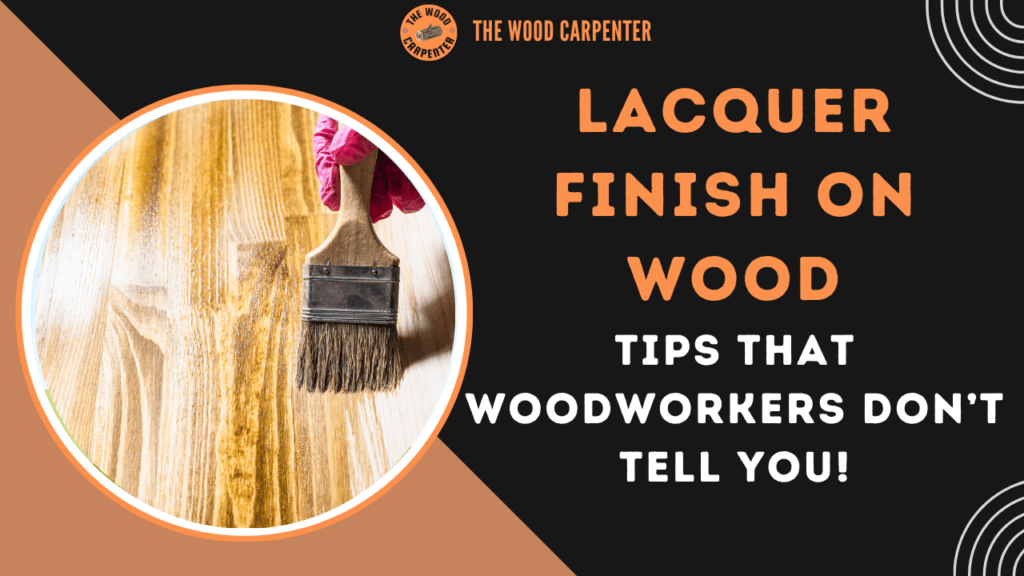
Putting a lacquer finish on wood is a traditional method that people have used for many years. It is well-loved because it makes the wood look clear, shiny, and rich, and it also protects the surface very well.
In this easy guide, you’ll learn what lacquer is, the different types, how to use it, its pros and cons, and how to take care of it. Whether you’re just starting out in woodworking or have lots of experience, this will help you improve your next project.
What is Lacquer?
Lacquer is a clear or colored coating you put on wood. It dries quickly and becomes a hard, shiny layer that protects the wood and makes it look beautiful. Long ago, people in Asia used natural tree sap to make lacquer. Today, we use modern versions made from chemicals, like nitrocellulose and acrylic lacquers.
Lacquer dries fast, has a glossy (shiny) finish, and shows off the natural wood grain very well. Unlike some finishes, it doesn’t turn yellow as time goes by.
Types of Lacquer
1. Nitrocellulose Lacquer
Dries quickly, forms a hard surface, and is easy to fix if damaged. Commonly used on furniture. It may turn slightly yellow as it gets older.
2. Acrylic Lacquer
Stays clear and doesn’t turn yellow over time. Great choice for light-colored wood.
3. Catalyzed Lacquer
Comes in two parts (pre-catalyzed or post-catalyzed). Very strong and resistant to chemicals. Often used for kitchen cabinets and other heavy-use wood items.
4. Waterborne Lacquer
Safer for the environment and has low harmful fumes (low VOCs). Works well for many indoor wood projects.
Why Use Lacquer on Wood ?
Advantages
Clear and Shiny Look: Makes the wood’s natural grain and color stand out beautifully.
Dries Fast: You can touch it in minutes and add more coats in just a few hours—great for finishing projects quickly.
Protects the Surface: Helps guard against scratches, water, and daily use.
Easy to Fix: New layers blend into the old ones, making repairs simple.
Different Looks Available: You can choose a flat matte or a super shiny finish.
Smooth Finish: Spraying gives a neat, even look like a pro.
Disadvantages
Strong Smell and Fumes: Has harmful chemicals—always wear a mask and work in a well-ventilated space.
Can Catch Fire Easily: The liquid and thinners are flammable. Keep away from heat and flames.
Not Very Resistant to Heat or Water: Doesn’t handle hot or wet surfaces as well as some other finishes.
Harder to Apply by Hand: Works best when sprayed. Brushing it on can lead to drips or streaks if you’re not careful.
Can Scratch Easily: It forms a thin coat, so it may scratch more than thicker finishes like polyurethane.
Also read:
Wood Finishes 101: Make the Right Choice for your project !
Lacquer Thinner vs Paint Thinner: Key Differences Explained
How to Apply Lacquer to Wood
Putting lacquer on wood isn’t as hard as it seems. Just follow these steps to get a smooth, professional-looking finish.
Step 1: Get the Wood Ready
- First, make sure the wood surface is smooth.
- Sand the wood using fine sandpaper (about 220 grit).
- After sanding, wipe off all the dust with a tack cloth or a soft, clean cloth.
Step 2: Pick the Right Lacquer
Choose a lacquer that fits your project:
- Use acrylic lacquer for light-colored furniture.
- For surfaces like floors, polyurethane might be better.
Step 3: Apply the Lacquer
- Use a brush, foam pad, or spray gun.
- Start at one end and move with the wood grain (the lines in the wood).
- Apply thin, even layers.
- Let each coat dry fully before adding the next.
Step 4: Sand Between Coats
After each coat dries, gently sand the surface using very fine sandpaper (about 320 grit).
This helps the next coat stick better and removes any small bumps.
Step 5: Final Coat and Drying Time
- Apply 3 to 5 coats in total.
- After the last coat, let it dry completely.
- Some types of lacquer need a few days to fully harden, so give it time.
Safety Tips
Always work in a space with fresh air (like near a window or outside).
Wear a safety mask (respirator) and gloves.
Throw away used rags and tools carefully, as they can catch fire easily.
Mineral Spirits vs Paint Thinner: What’s the Difference?
Comparing Lacquer with Other Wood Finishes
How does lacquer compare to other finishes like varnish, polyurethane, and oil-based finishes?
Lacquer vs. Varnish
- Lacquer dries quickly and gives a very shiny finish.
- Varnish takes longer to dry but is stronger and lasts longer.
- Use varnish for outdoor furniture (it handles weather better).
- Use lacquer for indoor furniture (for a smooth, glossy look).
Lacquer vs. Polyurethane
- Polyurethane is tougher and better for surfaces that get a lot of use (like floors or tables).
- Lacquer looks shinier and is easier to fix if it gets damaged.
- Choose polyurethane for durability; choose lacquer for a sleek, fancy finish.
Lacquer vs. Oil-Based Finishes
- Oil finishes give wood a warm, natural look and bring out the grain.
- But oil finishes don’t shine as much as lacquer and take longer to dry.
- Use oil finishes if you want a soft, classic look.
- Use lacquer if you want a glossy, smooth finish.
| Feature | Lacquer | Polyurethane | Varnish |
| Application | Spray (best) | Brush | Brush/Spray |
| Drying Time | Minutes | Hours | Hours |
| Sheen | Matte–Gloss | Semi–Gloss | Glossy |
| Repairability | Easy | Difficult | Moderate |
| Resistance | Good (interior) | Excellent | Moderate–Good |
| Odor/VOC | High | Moderate | High |
| Yellowing | Usually Low | Low–Medium | High (some) |
Taking Care of a Lacquer Finish
Cleaning
- Use a soft cloth and a gentle furniture polish.
- Don’t use too much water.
Fixing Scratches
- Small scratches can be gently polished.
- For deep scratches, lightly sand and spray on a new coat.
Restoring Old Finishes
Clean the surface, sand lightly, and spray on fresh lacquer to bring it back to life.
Things to Watch Out For
Too much moisture or heat can damage lacquer over time, faster than some other finishes.
Where Is Lacquer Used ?
Lacquer is perfect for making wood look shiny and smooth. Common uses include:
Furniture – Tables, chairs, and cabinets
Musical Instruments – Like guitars for beauty and protection
Decorative Items – Picture frames, sculptures, small wooden crafts
Helpful Tips and Common Mistakes
Don’t go over wet areas – Lacquer dries fast and will streak if brushed too much.
Layering is easy – New coats stick well to old ones, so it’s more forgiving than varnish or polyurethane.
Ventilate well – The fumes are strong and can be harmful—work in fresh air.
Cover edges properly – Edges and ends soak up more lacquer, so apply evenly.
Final Thoughts
A lacquer finish gives wood a clean, glossy, and professional look. While you need to be careful during application and protect yourself from fumes, the result is beautiful, strong, and easy to repair.
Whether you want a shiny surface or a soft matte look, lacquer is a great choice for many woodworking projects.
FAQs – Common Questions About Lacquer
1. What is lacquer, and how is it different?
Lacquer is a clear or colored wood coating that dries fast and gives a shiny finish. Unlike varnish or polyurethane, it’s often sprayed on and can be layered easily.
2. Can I use a brush to apply lacquer?
Yes, but spraying is better for a smooth finish. If brushing, use a special brush-on lacquer and work quickly with even strokes.
3. Is lacquer strong enough for everyday use?
Yes, it’s great for furniture and decorative items, but it’s not the best for wet or hot surfaces. It can scratch or wear with heavy use.
4. How many coats should I apply?
Usually, 3–5 thin coats are enough. Since it dries fast, you can apply several coats in one day.
5. How long does it take to dry and cure?
Each coat dries in about 15–30 minutes. For best results, let it cure fully for 1–2 days before using the item.
6. Can I put lacquer over paint or stain?
Yes, but make sure the stain or paint is fully dry. Test first to make sure the lacquer won’t react with it.
7. Is lacquer safe for food surfaces?
No. Regular lacquer has chemicals that aren’t safe for cutting boards or kitchen surfaces. Use food-safe finishes for those.
8. How do I fix damage?
Polish out light scratches. For deeper ones, clean, sand lightly, and spray on a new coat—it blends in easily.
9. Will lacquer turn yellow or cloudy over time?
Some types, like nitrocellulose lacquer, may yellow. But acrylic and water-based lacquers stay clear, even on light wood.
10. Is lacquer waterproof?
It’s water-resistant, not waterproof. Don’t let water sit on the surface for too long, or it may get damaged.
11. What safety steps should I follow?
- Work in fresh air
- Wear a mask (respirator) and gloves
- Stay away from flames—lacquer and its fumes are flammable
12. How do I keep lacquered wood clean?
Dust with a soft cloth. Use only a little water, and avoid strong cleaners. Buff out small marks with polish if needed.

